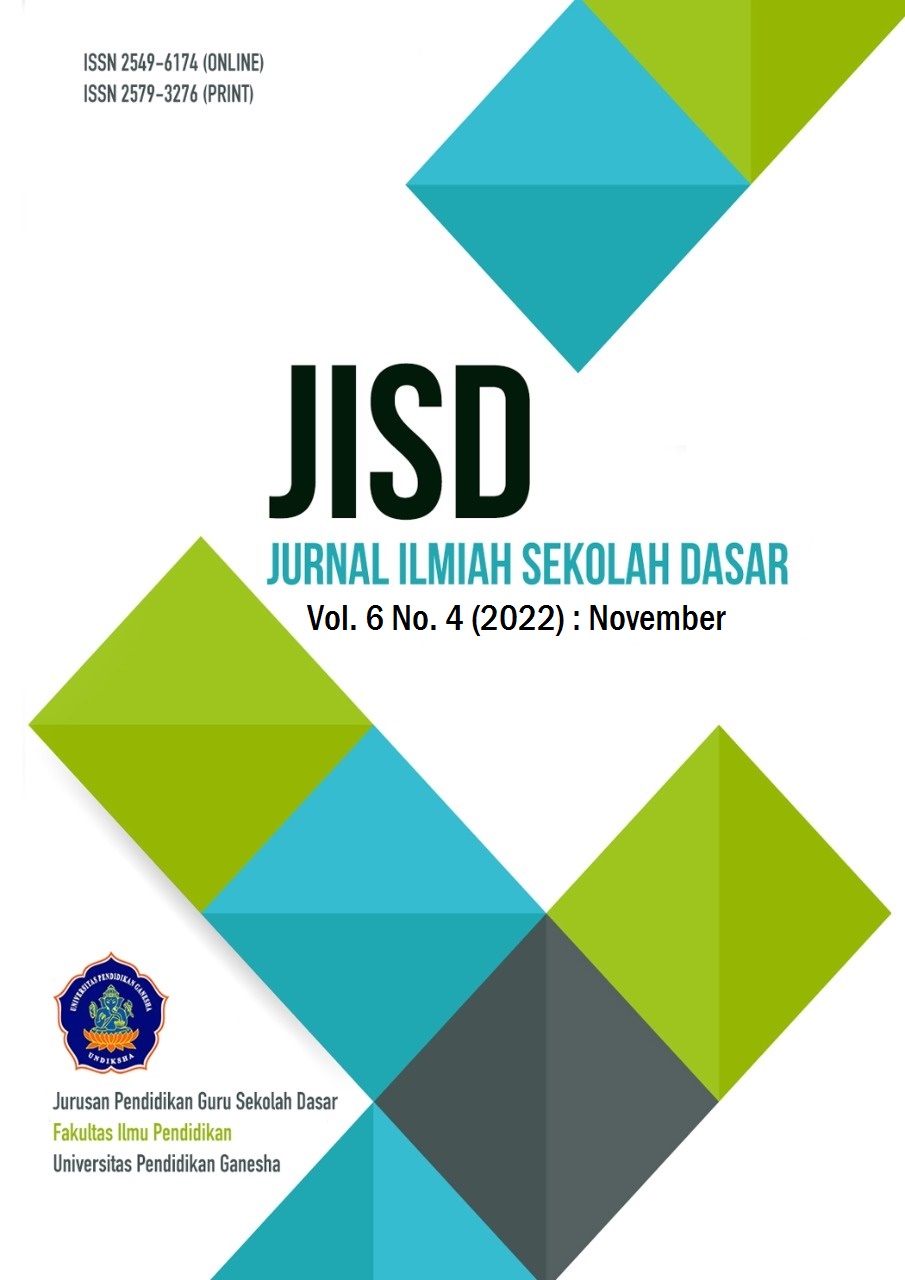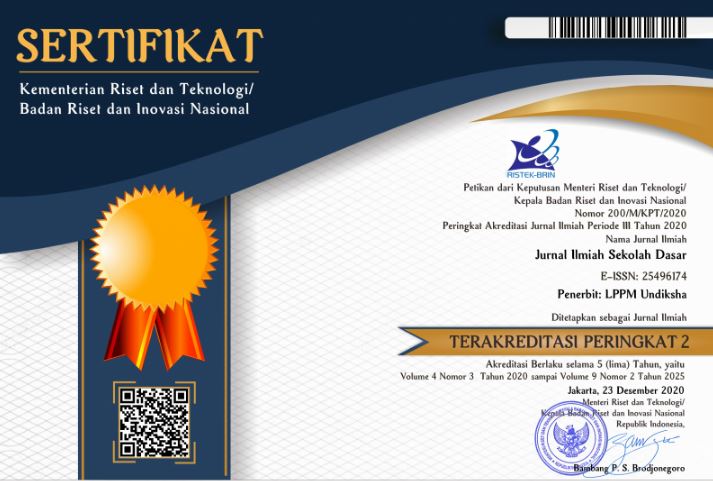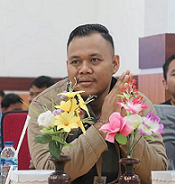Integrated Thematic Teaching Materials with PjBL Based on Book Creator Application in Grade IV Elementary School
DOI:
https://doi.org/10.23887/jisd.v6i4.52970Keywords:
Teaching Materials, PjBL, Book Creator Application , ValidityAbstract
Integrated thematic learning has the aim of presenting complete learning and experience for students. However, the data and information obtained at the research stage through interviews involving teachers and IV grade students Elementary School still obtained the use of printed teaching materials which were not attractive because the paper material used was paper newspaper type. So that the use of teaching materials cannot attract the attention of students, according to several studies, it causes students' understanding and knowledge to be not optimal. This study aims to create and determine the validity of integrated thematic teaching materials with the PjBL model based on the book creator application in the IV grade of elementary school. This development research uses the Borg and Gall model. Where the research starts from the stages of potential and problems to product trials. The instruments used in this research activity are interviews and validation sheets. Based on the problems found at the potential and problem stages, teaching materials were designed with the PjBL model based on the book creator application. Where after being validated by five validators, the following results were found, the language aspect in the valid category, the content aspect in the very valid category, the presentation aspect in the valid category, and the graphic aspect in the very valid category.
References
Alfiani, R., Delawanti, D., & HalimatusSakdiyah, S. (2021). Pengembangan Modul Berbasis Digital dalam Menanamkan Nilai-Nilai Karakter Siswa KElas IV Sekolah Dasar. Seminar Nasional PGSD UNIKAMA, 5(69), 707–716. https://conference.unikama.ac.id/artikel/index.php/pgsd/article/view/591.
Anggoro, F. K., Stein, N. L., & Jee, B. D. (2012). Cognitive factors that influence children’s learning from a multimedia science lesson. International Electronic Journal of Elementary Education, 5(1), 93–108. https://iejee.com/index.php/IEJEE/article/download/12/10.
Anjarwati, A. A. (2021). Penyusunan E-Modul Sistem Imun Kelas XI Berbasis Potensi Alam Lokal Menggunakan Aplikasi Book Creator pada Pembelajaran Daring. Prosiding SNST Ke-11 Tahun 2021 Fakultas Teknik Universitas Wahid Hasyim, 115–121. https://publikasiilmiah.unwahas.ac.id/index.php/PROSIDING_SNST_FT/article/view/5099.
Century, J., Ferris, K. A., & Zuo, H. (2020). Finding time for computer science in the elementary school day: a quasi-experimental study of a transdisciplinary problem-based learning approach. International Journal of STEM Education, 7(1). https://doi.org/10.1186/s40594-020-00218-3. DOI: https://doi.org/10.1186/s40594-020-00218-3
Delfakhria, D., & Solfema, S. (2022). Development of Integrated Thematic Teaching Materials with Mind Mapping Model in Class III of Elementary School. AL-ISHLAH: Jurnal Pendidikan, 14(2), 2313–2326. https://doi.org/10.35445/alishlah.v14i2.1282. DOI: https://doi.org/10.35445/alishlah.v14i2.1282
Desyandri, D., & Maulani, P. (2020). Penerapan Model Project Based Learning untuk Meningkatkan Hasil Belajar Seni Musik Pada Pembelajaran Tematik Terpadu di Sekolah Dasar. Jurnal Inovasi Pendidikan Dan Pembelajaran Sekolah Dasar, 3(2), 58. https://doi.org/10.24036/jippsd.v3i2.107576. DOI: https://doi.org/10.24036/jippsd.v3i2.107576
Dolapcioglu, S., & Doğanay, A. (2020). Development of critical thinking in mathematics classes via authentic learning: an action research. International Journal of Mathematical Education in Science and Technology. https://doi.org/10.1080/0020739X.2020.1819573. DOI: https://doi.org/10.1080/0020739X.2020.1819573
Džanić, N. D., & Pejić, A. (2016). The Effect of Using Songs On Young Learners and Their Motivation for Learning English. NETSOL: New Trends in Social and Liberal Sciences, 1(2), 40–54. https://doi.org/10.24819/netsol2016.8. DOI: https://doi.org/10.24819/netsol2016.8
Edli, H., & Mudjiran, M. (2015). Perbedaan Motivasi dan Keterampilan Belajar Peserta Didik Berprestasi Tinggi dan Rendah Serta Implikasi dalam Bimbingan dan Konseling. Konselor, 4(1), 26. https://doi.org/10.24036/02015416452-0-00. DOI: https://doi.org/10.24036/02015416452-0-00
Fahmi, S., Priwantoro, S. W., Cahdriyana, R. A., Hendroanto, A., Rohmah, S. N., & Nisa, L. C. (2019). Interactive Learning Media Using Kvisoft Flipbook Maker for Mathematics Learning. Journal of Physics: Conference Series, 1188(1). https://doi.org/10.1088/1742-6596/1188/1/012075. DOI: https://doi.org/10.1088/1742-6596/1188/1/012075
Fitria, Y., Helsa, Y., Nirwana, H., & Zulkarnaini, A. P. (2018). The integration of science and math. Journal of Physics: Conference Series, 1088. https://doi.org/10.1088/1742-6596/1088/1/012041. DOI: https://doi.org/10.1088/1742-6596/1088/1/012041
Ghory, S., & Ghafory, H. (2021). The impact of modern technology in the teaching and learning process. International Journal of Innovative Research and Scientific Studies, 4(3), 168–173. https://doi.org/10.53894/ijirss.v4i3.73. DOI: https://doi.org/10.53894/ijirss.v4i3.73
Ghufron, M. . (2018). Revolusi Industri 4.0: Tantangan, Peluang, Dan Solusi Bagi Dunia Pendidikan. Seminar Nasional Dan Diskusi Panel Multidisiplin Hasil Penelitian Dan Pengabdian Kepada Masyarakat 2018, 1(1), 332–337. http://www.proceeding.unindra.ac.id/index.php/dispanas2018/article/viewFile/73/45.
Hanif Batubara, I., Saragih, S., Syahputra, E., Armanto, D., Sari, I. P., Lubis, B. S., Febri, E., & Siregar, S. (2022). Mapping Research Developments on Mathematics Communication: Bibliometric Study by VosViewer. Al -Ishlah Jurnal Pendidikan, 14(3), 2637–2648. https://doi.org/10.35445/alishlah.v14i1.925. DOI: https://doi.org/10.35445/alishlah.v14i3.925
Happy, N., & Widjajanti, D. B. (2016). Keefektifan Pbl Ditinjau Dari Kemampuan Berpikir Kritis Dan Kreatif Matematis, Serta Self-Esteem Siswa Smp. Jurnal Riset Pendidikan Matematika, 1(1), 48. https://doi.org/10.21831/jrpm.v1i1.2663. DOI: https://doi.org/10.21831/jrpm.v1i1.2663
Hendrizal, & Chandra. (2018). Preliminary Research Description In Developing Tematics Learning Materials by Using Character Building and Discovery Learning to Establish Children aged 6-9 Years. International Conference of Early Childhood Education, 169, 95–101. https://doi.org/10.2991/icece-17.2018.23. DOI: https://doi.org/10.2991/icece-17.2018.23
Ima Wahyu Putri Utami, B. I. S. (2019). Perencanaan Pembelajaran Tematik Berbasis Kearifan Lokal Di SD MuhammadiyaH I Malang. 02(01), 9–25. https://doi.org/https://doi.org/10.30738/tc.v2i1. DOI: https://doi.org/10.30738/tc.v2i1
Kantun, S., & Budiawati, Y. S. R. (2016). Analisis Tingkat Kelayakan Bahan Ajar Ekonomi yang Digunakan Oleh Guru di SMA Negeri 4 Jember. Jurnal Pendidikan Ekonomi, 9(2), 129–146. http://jurnal.unej.ac.id/index.php/JPE/article/view/3384.
Khairi, A., & Miaz, Y. (2020). Peningkatan Hasil Belajar Peserta Didik Pada Tematik Terpadu Dengan Menggunakan Model PBL di Kelas IV SD. E-Journal Pembelajaran Inovasi, Jurnal Ilmiah Pendidikan Dasar, 8(8), 1577–1581. http://ejournal.unp.ac.id/students/index.php/pgsd/article/view/10421.
Mufit, F., Festiyed, F., Fauzan, A., & Lufri, L. (2018). Impact of Learning Model Based on Cognitive Conflict toward Student’s Conceptual Understanding. IOP Conference Series: Materials Science and Engineering, 335(1). https://doi.org/10.1088/1757-899X/335/1/012072. DOI: https://doi.org/10.1088/1757-899X/335/1/012072
Nurhadiyati, A., Rusdinal, & Fitria, Y. (2021). Pengaruh Model Project Based Learning (PjBL) terhadap Hasil Belajar Siswa Di Sekolah Dasar. Jurnal Basicedu, 5(1), 2247–2255. https://doi.org/10.31004/basicedu.v5i1.684. DOI: https://doi.org/10.31004/basicedu.v5i1.684
Prawiyogi, A. G., Fitri, A., & Suhardiman, S. (2020). Use Of Big Book Media Towards Interest In Reading Elementary School Students. International Journal of Theory and Application in Elementary and Secondary School Education, 2(1), 8–11. https://doi.org/10.31098/ijtaese.v2i1.164. DOI: https://doi.org/10.31098/ijtaese.v2i1.164
Qhadafi, M. R. (2018). Analisis Kesalahan Penulisan Ejaan yang Disempurnakan dalam Teks Negosiasi Siswa SMA Negeri 3 Palu. Jurnal Bahasa Dan Sastra, 3(4), 1–21. https://core.ac.uk/download/pdf/289713947.pdf.
Saputra, B., & Sujarwanta, A. (2021). Tranformasi Pembelajaran Berbasis Proyek Science, Technology, Engineering and Mathematics di Masa Pandemi Covid-19. BIOLOVA, 2(1), 1–8. https://doi.org/10.24127/biolova.v2i1.491. DOI: https://doi.org/10.24127/biolova.v2i1.491
Sari, R. T., & Angreni, S. (2018). Penerapan Model Pembelajaran Project Based Learning (PjBL) Upaya Peningkatan Kreativitas Mahasiswa. Jurnal VARIDIKA, 30(1), 79–83. https://doi.org/10.23917/varidika.v30i1.6548. DOI: https://doi.org/10.23917/varidika.v30i1.6548
Sarkadi, & Iqbal, A. M. (2020). Teaching Materials of Thematic Comics in the 2013 Curriculum Learning in Basic Schools. Jurnal Pendidikan Indonesia : Indonesian of Educational Journal, 9(4), 618–627. https://doi.org/10.23887/jpi-undiksha.v9i4.20908. DOI: https://doi.org/10.23887/jpi-undiksha.v9i4.20908
Sheromova, T. S., Khuziakhmetov, A. N., Kazinets, V. A., Sizova, Z. M., Buslaev, S. I., & Borodianskaia, E. A. (2020). Learning styles and development of cognitive skills in mathematics learning. Eurasia Journal of Mathematics, Science and Technology Education, 16(11). https://doi.org/10.29333/EJMSTE/8538. DOI: https://doi.org/10.29333/ejmste/8538
Siti Rodi’ah, I. H. (2021). Strategi Pembelajaran Pendidikan Jasmani Berbantu Media Book Creator Digital Dalam Meningkatkan Kemampuan Motorik Kasar Siswa Pada Tingkat Sekolah Dasar. Continuous Education: Journal of Science and Research, 2(2), 23–35. https://doi.org/10.51178/ce.v2i2.225. DOI: https://doi.org/10.51178/ce.v2i2.225
Steenhuis, H.-J., & Rowland, L. (2018). Project-Based Learning (T. J. Kloppenborg (ed.)). Business Expert Press.
Sugiyono. (2016). Metode Penelitian Pendidikan. ALFABETA.
Sunita, N. W., Mahendra, E., & Lesdyantari, E. (2019). Pengaruh Model Pembelajaran Project Based Learning terhadap Minat Belajar dan Hasil Belajar Matematika Peserta Didik. Widyadari: Jurnal Pendidikan, 20(1), 1–16. https://doi.org/10.5281/zenodo.2655018. DOI: https://doi.org/10.30656/gauss.v1i1.639
Suryaningtyas, A., Kimianti, F., & Prasetyo, Z. K. (2020). Developing Science Electronic Module Based on Problem-Based Learning and Guided Discovery Learning to Increase Critical Thinking and Problem-Solving Skills. 401(Iceri 2019), 65–70. https://doi.org/10.2991/assehr.k.200204.013. DOI: https://doi.org/10.2991/assehr.k.200204.013
Tinja, Y., Towaf, S. M., & Hariyono. (2017). Pengembangan Bahan Ajar Tematik Berbasis Kearifan Lokal Sebagai Upaya Melestarikan Nilai Budaya Pada Siswa Sekolah Dasar. Jurnal Pendidikan: Teori, Penelitian, Dan Pengembangan, 2(9), 1257–1261. https://doi.org/10.17977/jptpp.v2i9.9990.
Valenci, C., & Winata, T. (2020). Ruang kreatif digital. Jurnal Sains, Teknologi, Urban, Perancangan, Arsitektur (Stupa), 1(2), 2075. https://doi.org/10.24912/stupa.v1i2.4435. DOI: https://doi.org/10.24912/stupa.v1i2.4435
Wilianto, & Kurniawan, A. (2018). Sejarah, Cara Kerja dan Manfaat Internet of Things. Jurnal MATRIX, 8(2), 36–41. https://doi.org/10.31940/matrix.v8i2.818. DOI: https://doi.org/10.31940/matrix.v8i2.818
Downloads
Published
How to Cite
Issue
Section
License
Copyright (c) 2022 Diren Agasi, Desyandri

This work is licensed under a Creative Commons Attribution-ShareAlike 4.0 International License.
Authors who publish with the Journal Ilmiah Sekolah Dasar agree to the following terms:
- Authors retain copyright and grant the journal the right of first publication with the work simultaneously licensed under a Creative Commons Attribution License (CC BY-SA 4.0) that allows others to share the work with an acknowledgment of the work's authorship and initial publication in this journal.
- Authors are able to enter into separate, additional contractual arrangements for the non-exclusive distribution of the journal's published version of the work (e.g., post it to an institutional repository or publish it in a book), with an acknowledgment of its initial publication in this journal.
- Authors are permitted and encouraged to post their work online (e.g., in institutional repositories or on their website) prior to and during the submission process, as it can lead to productive exchanges, as well as earlier and greater citation of published work. (See The Effect of Open Access)










